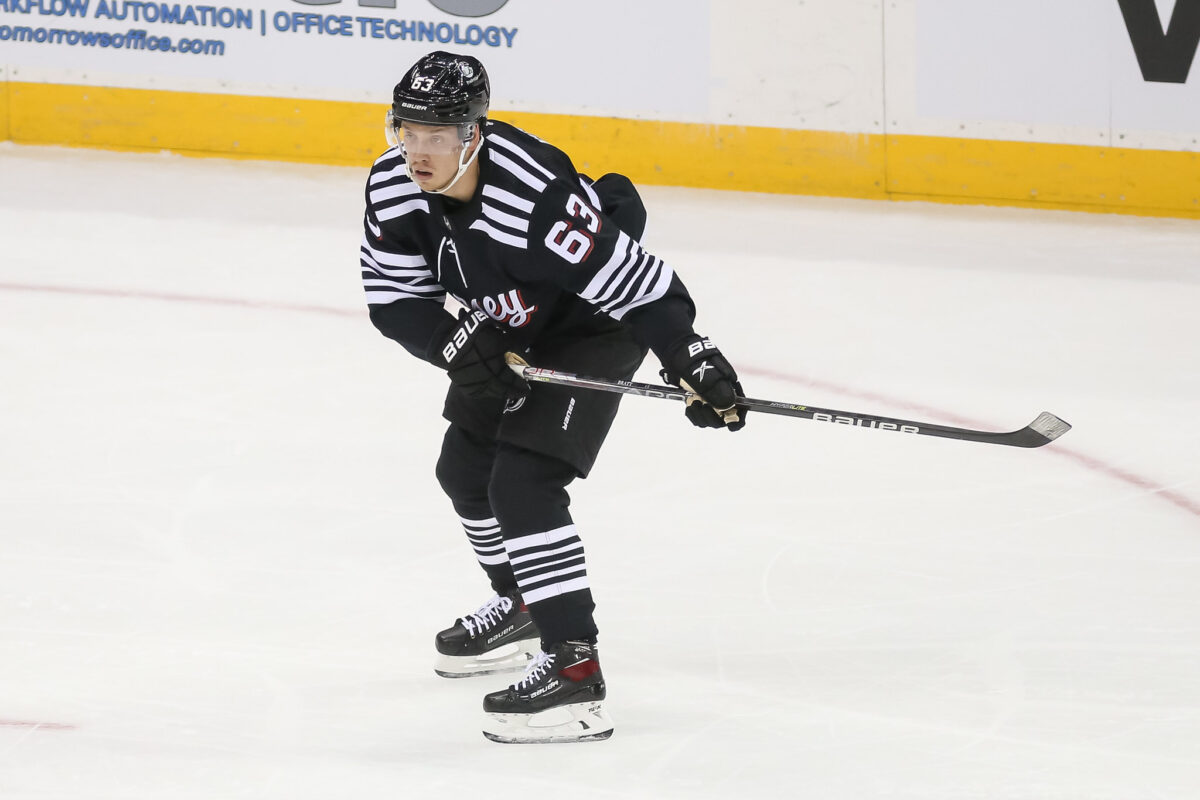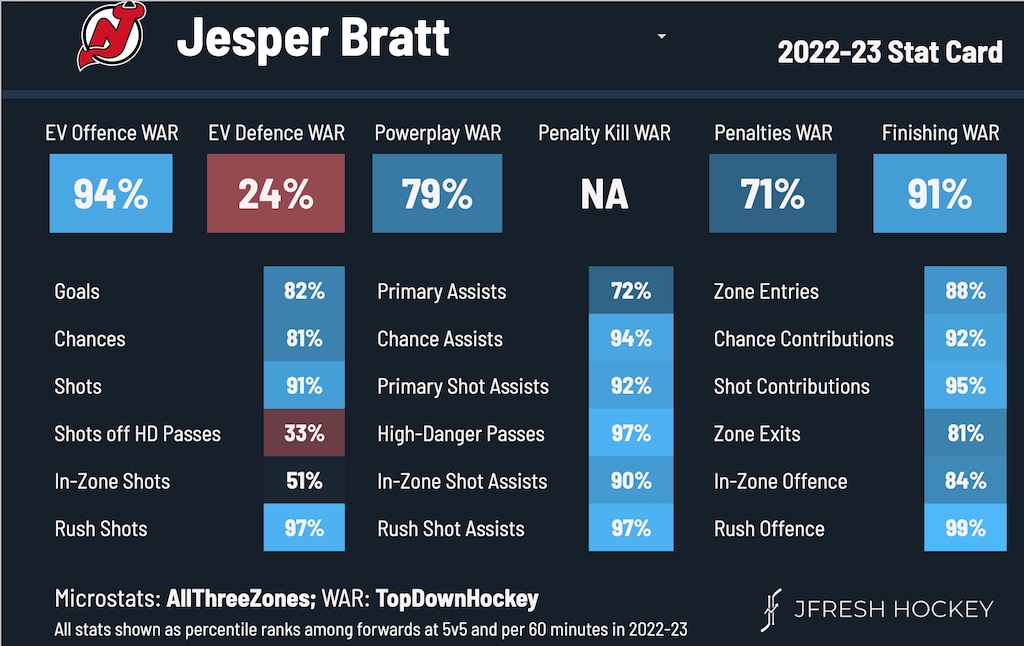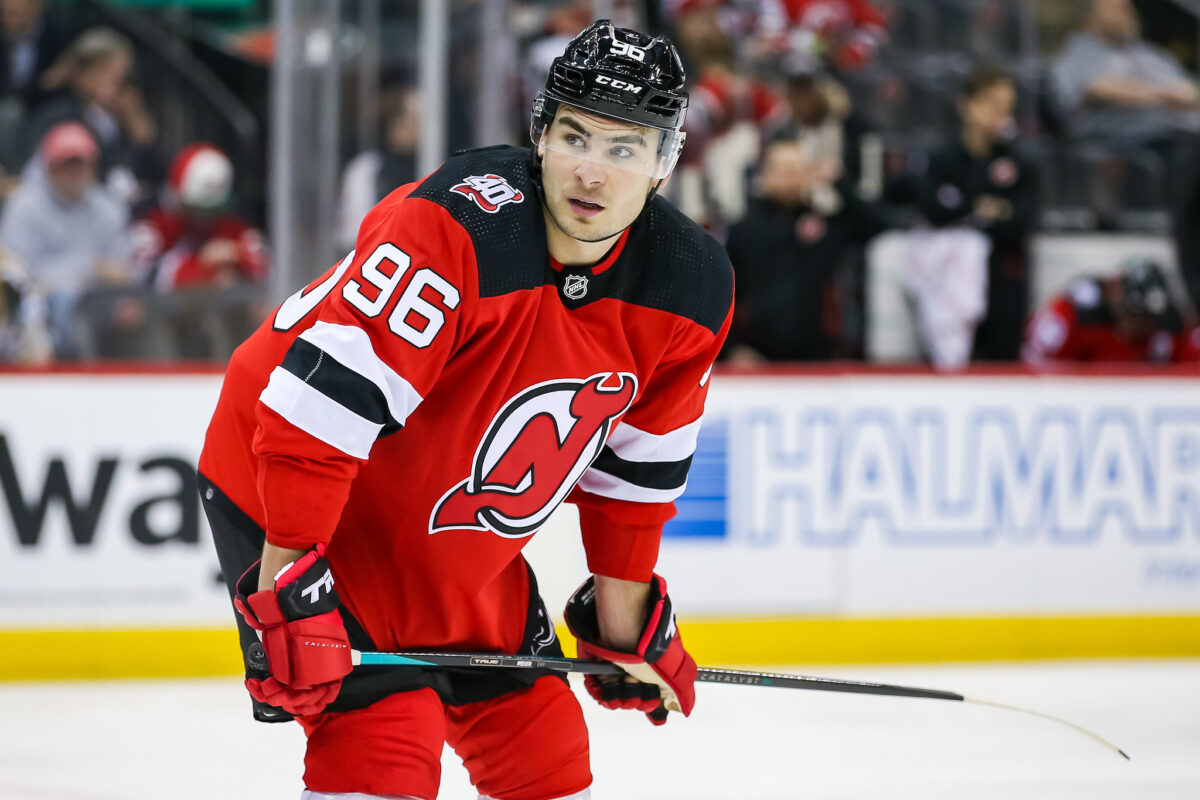Early yesterday (June 15) afternoon, Pierre LeBrun and Elliotte Friedman reported that the New Jersey Devils and Jesper Bratt were closing in on an eight-year deal at a cap hit of $7.875 million. Shortly afterward, the team made it official, announcing they had inked the Swedish winger to an eight-year deal worth a total of $63 million — his jersey number — and the previously mentioned cap hit.
Bratt is coming off the best season of his career, finishing with 32 goals and 41 assists in 82 games. That follows up a 2021-22 campaign that saw him break out and show that he could have a place as one of the Devils’ core members as they enter contender mode. His new deal cements his status as a foundation player, and the Devils should find great value for most of his contract in signing him to a cap hit of just under $8 million.
Bratt Backed Up 2021-22 Breakout Year
Bratt has been one of the Devils’ better players since he made their NHL roster as a rookie out of camp for the 2017-18 season. The former sixth-round pick finished that year with 13 goals and 35 points in 74 games. Over the next three seasons, he’d continue to show progress, producing at a 50-point pace per 82 games.
But when Bratt started to show signs of a potential breakout was during the COVID-shortened 2020-21 campaign, Lindy Ruff’s first as Devils head coach. Though Bratt only finished with seven goals and 30 points in 46 games that year, his impacts began to show a relatively significant uptick. He concluded that season with a 53.57 expected goals percentage (xG%) at five-on-five and averaged 1.88 points per 60 minutes.

Most importantly, he began to show play-driving ability. That carried over into the 2021-22 season when Bratt had his long-awaited breakout year. His shot improved significantly, and he ended with a career-high 26 goals and 73 points. He finished second on the team in xG% to Fabian Zetterlund and was the team’s second-most efficient five-on-five scorer behind Zetterlund.
Unable to agree to a long-term deal last summer, the two sides settled on a one-year pact worth $5.45 million, making him an RFA again this offseason. Bratt seized the opportunity and proved that his 2021-22 campaign was no fluke. He set another career-high in goals and was the team’s best play driver after Jack Hughes.
When looking at Bratt’s microstats, it’s not a surprise to see why his expected numbers were so impressive in 2022-23; he finished with a 58.76 xG%. He ranked in the 97th percentile in shots off the rush and in the 99th percentile in rush offense. He’s one of the best players in the league at generating chances in high-danger areas, and he does a great job of setting up his teammates for shots on goal (primary shot assists):

It’s rare to find a winger who has the play-driving ability of Bratt. Usually, it’s a center such as Hughes or Nico Hischier. But with Bratt, the Devils have a third key cog who can help lead their offense (and likely a fourth after Timo Meier re-signs). When a player’s microstats look like Bratt’s, that’s usually predictive of future success, specifically for someone who thrives in transition in a rush-based system. And there’s a good chance he will continue to perform this way throughout his contract.
Bratt & Fiala a Match
Evolving-Hockey had Bratt projected for a cap hit just above $8.3 million on an eight-year deal. It’s not a bargain, but getting that number below $8 million is a win for the Devils, especially with a salary cap expected to rise significantly over the next few years. That could turn Bratt’s contract into one of the most valuable in the NHL if he continues to produce at 30-goal, 70-point paces.
When looking for contract comparables via CapFriendly, Kevin Fiala’s extension with the Los Angeles Kings is a 90 percent match to Bratt’s. After getting traded to the Kings from the Minnesota Wild last summer, Fiala signed a seven-year extension at an identical cap hit of $7.875 million. Fiala, like Bratt, was an RFA with arbitration rights and was one year away from UFA status.
Related: Devils 2023 Offseason Trade Target: Nick Schmaltz
Both players have similar makeups — high-end skating wingers who excel in transition and can drive play — and their production was nearly identical when they signed their contracts. It was always the most reasonable comparable for a Bratt extension, so it’s not a surprise to see such a resemblance between the two deals.
Bratt’s contract should age pretty well, too, just like Fiala’s. The former turns 25 years old at the end of July, so he’s currently in his prime and should be for the first half of the deal at a minimum. Using The Athletic’s model, Bratt projects to bring positive value for nearly all of his new contract.
For those familiar with Dom Luczyszyn’s game score value added metric (GSVA) at The Athletic, Offensive and Defensive Rating are just an improved GSVA. Offensive Rating predicts a team or individual’s ability to score above league average, and Defensive Rating is the ability to suppress goals above league average (From “Introducing the ‘new’ NHL stats fans should know: Offensive and Defensive Rating” – The Athletic, 4/12/2023).
Bratt is about a league-average defender, but he’s well above average offensively and has even better seasons expected to come over the next few years. Even when he could potentially start dropping off by 30 years old, he still projects to be a significant net positive offensively. And with the cap ceiling likely to be much higher by then, there’s potential for incredible value in having him at $7.875 million a year.
It’s also important to note that the Devils and general manager Tom Fitzgerald got Bratt under Hughes’ $8 million cap hit. The Devils have a bit of a salary hierarchy in that they don’t want to pay forwards much above Hughes’ number. That probably won’t work for extending Meier, and it won’t as the salary cap continues to rise, but it worked here. That sets up the Devils to have extra cap flexibility in the years to come.
With Bratt Done, Meier Becomes the Priority
Now that the Devils and Fitzgerald have Bratt signed to a new contract, they can focus on Meier, who they acquired at the trade deadline; he’s also an RFA with arbitration rights this offseason. Meier’s cap hit will be higher than Bratt’s, perhaps around $9 million annually, but the Devils have plenty of cap space to make that work. Even after re-signing Bratt, they have $26,407,500 in cap space. That puts them $4,607,500 below the cap floor, so re-signing Meier shouldn’t be an issue.
After getting Meier inked to a new deal, Fitzgerald should have around $17 million to work with for the rest of the offseason. They’d still have some housekeeping to address, like re-signing Erik Haula — who’s a pending UFA — and Nathan Bastian and some other RFAs, but they shouldn’t cost much on new deals.

Fitzgerald will probably have to make a move or two to shed salary if he wants to make external additions, so a pending RFA like Yegor Sharangovich or Jesper Boqvist may get traded in the coming weeks. But the team’s long-term cap situation looks pretty clean, even after they re-sign Meier, and especially with a big jump in the cap ceiling expected in 2024.
The Devils have had their fair share of grinding negotiations with Bratt, but with him one year away from being a UFA, it was getting close to crunch time for a long-term extension. The two sides sealed the deal with plenty of time to spare, but early enough in the offseason to give Fitzgerald a better idea of how to attack trades and free agency. And he now has three core players locked up through their primes in Bratt, Hughes and Hischier.
* * *
Advanced stats from Natural Stat Trick
